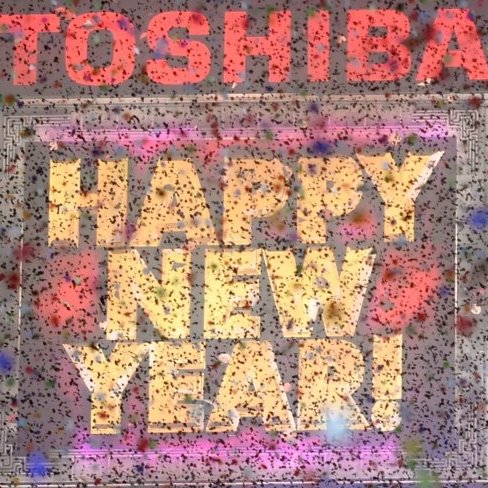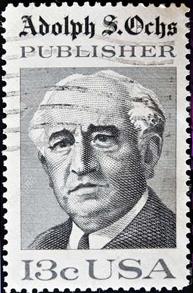
Community

Jew who started NY’s ball-drop
ANT KATZ
When one million people are crammed into New York’s Times Square on New Year’s Eve to watch a giant crystal ball descend, and a further one billion people tuned in from all over the world – how many would have known that the man who started the tradition was newspaper magnate Adolph Simon Ochs.
The traditional celebration now includes so much confetti, that it almost obscured the ball tower in the Huffington Post picture, above.
The son of German-Jewish immigrants, Ochs (1858–1935) he began his career as an 11-year-old office boy at the Knoxville Chronicle.
 By 19 he was publisher of The Chattanooga Times (now the Chattanooga Times Free Press), and at 38 he purchased the struggling New York Times, instilling a focus on objective journalism.
By 19 he was publisher of The Chattanooga Times (now the Chattanooga Times Free Press), and at 38 he purchased the struggling New York Times, instilling a focus on objective journalism.
RIGHT: In 1976 the US issued this
postage stamp commemorating Ochs
After Ochs bought the Times in 1896, he moved its headquarters to the intersection of Broadway, Seventh Avenue and 42nd Street.
In 1904 Ochs convinced Mayor George McClellan to rename the then-Longacre Square after the newspaper.
That New Year’s Eve, Ochs celebrated with a public fireworks show, in part to draw New Yorkers from their traditional gathering spot of Wall Street, where they listened to the chiming of bells at Trinity Church.
 But, when three years later he was denied a fireworks permit, he hired sign maker Artkraft Strauss to build, and then lower, a 700-pound wood-and-iron ball. It was five feet across and covered in 100 light bulbs.
But, when three years later he was denied a fireworks permit, he hired sign maker Artkraft Strauss to build, and then lower, a 700-pound wood-and-iron ball. It was five feet across and covered in 100 light bulbs.
LEFT: The present Times Square Ball is Ochs’ unique legacy. It has ballooned to 11 875 pounds, 12 feet in diameter, and covered in 32 256 LED lights!
Ochs didn’t invent the time ball – they had been used since the early 1800s for synchronising maritime clocks, and by 1907 they were fixtures in dozens of cities.
Who was Adolph Simon Ochs?
Ochs was born in Cincinnati, Ohio, to a Jewish family, Julius Ochs and Bertha Levy, who were both German immigrants. His father had left Bavaria for the US in 1846, a highly educated man and fluent in six languages which he gave instruction in at schools in the South. He sided with the Union during the war. Bertha, who had come to the United States in 1848, a refugee from Rhenish Bavaria and the revolution there, had lived in the South before her 1853 marriage with Julius, and during the war sympathised with the South, though their differing sympathies didn’t separate their household.
After the war, the family moved to Knoxville, Tennessee. In Knoxville, Adolph studied in the public schools and during his spare time delivered newspapers. At 11, he went to work at the Knoxville Chronicle as office boy to William Rule, the editor, who became a mentor. In 1871 he was a grocer’s clerk at Providence, Rhode Island, while attending a night school. He then returned to Knoxville, where he was a druggist’s apprentice for some time. In 1872, he returned to the Chronicle as a “printer’s devil”, who looked after various details in the composing room of the paper.
His siblings also worked at the newspaper to supplement the income of their father, a lay rabbi for Knoxville’s small Jewish community. The Chronicle was the only Republican, pro-Reconstruction, newspaper in the city, but Ochs counted Father Ryan, the Poet-Priest of the Confederacy, among his customers.
At the age of 19, Ochs borrowed $250 from his family to purchase a controlling interest in The Chattanooga Times, becoming its publisher. The following year he founded a commercial paper called The Tradesman. He was one of the founders of the Southern Associated Press and served as president. In 1896, at the age of 38, he heard that the New York Times could be picked up for a song as it was suffering severe financial losses as new competitors entered the market.
In 1884, Ochs married Effie Wise, the daughter of Rabbi Isaac Mayer Wise of Cincinnati, who was the leading exponent of Reform Judaism in America and the founder of Hebrew Union College.
Borrowing money to purchase The Times, Ochs formed the New York Times Co and placed the paper on a strong financial foundation. He became the majority stockholder and shifted their focus to objective journalism, in a time when newspapers were openly and highly partisan.
Ochs also instituted a well-timed price decrease (from 3¢ to 1¢ per issue) which added further impetus to its rescue. The paper’s readership increased from 9 000 at the time of his purchase to 780 000 by the 1920s.
In 1901, Ochs became proprietor and editor of the Philadelphia Times, later merged in the Philadelphia Public Ledger, of which he was sole owner from 1902–12, when he sold it to Cyrus Curtis.
In 1928 Ochs built the Mizpah Congregation Temple in Chattanooga in memory of his parents, Julius and Bertha Ochs. The Georgian colonial building was designated as a Tennessee Historical Preservation Site in 1979.
Fought anti-Semitism, ADL crusader
Ochs was engaged in crusading against anti-Semitism. He was active in the early years of the Anti-Defamation League, serving as an executive board member, and used his influence as publisher of the New York Times to convince other newspapers nationwide to cease the unjustified caricaturing and lampooning of Jews in the American press.
Ochs died on April 8, 1935, during a visit to Chattanooga. He is buried at the Temple Israel Cemetery in New York. From his single offspring, Ochs began a publishing dynasy.
His daughter, Iphigene Bertha Ochs, married Arthur Hays Sulzberger who went on to become publisher of the Times after Adolph died. Iphigene’s son-in-law, Orvil Dryfoos, was publisher from 1961–63, followed by her son Arthur Ochs “Punch” Sulzberger. Her daughter, Ruth Holmberg, became publisher of The Chattanooga Times.
Ruth Holmberg’s son is Arthur Golden, author of Memoirs of a Geisha. Ochs’ great-grandson Arthur Ochs Sulzberger Jr became the publisher of The New York Times since 1992.
One of Adolph’s nephews, Julius Ochs Adler, worked at The New York Times for more than 40 years, becoming general manager in 1935, after Ochs died. Another nephew, John Bertram Oakes, the son of his brother George Washington Ochs Oakes, became editorial page editor of the Times’ editorial page in 1961, which he edited until 1976.





Sue Miller
May 5, 2016 at 2:56 pm
‘I find the history of oches family very interesting and current members lead interesting and productive lives.’